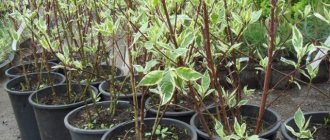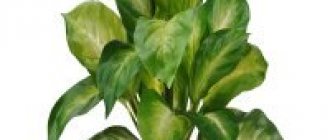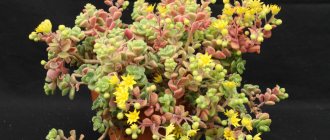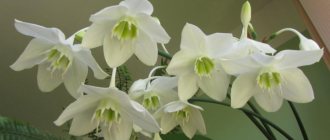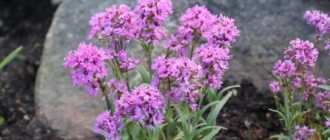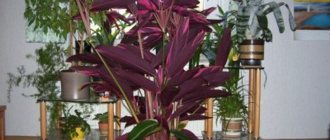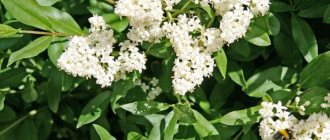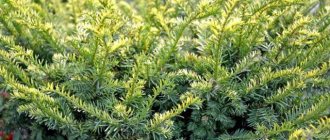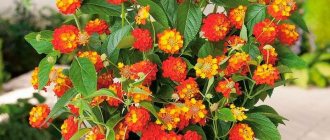general description
Derain (Cornus), or svidina, is a genus of decorative deciduous shrubs of the dogwood family; it unites several dozen species (both deciduous and evergreen), most of which grow in temperate latitudes of the Northern Hemisphere. This genus of shrubs is distinguished by its absolute undemanding conditions and excellent frost resistance. And in addition, they are very decorative, all year round. In spring and summer, derain pleases us with its beautiful foliage (especially variegated varieties) and cute flowers. In autumn, the foliage becomes especially bright and amazing fruits ripen in white, black, blue or reddish shades. In winter, it will also not get lost in the garden, because the bark of its shoots can have rich green, yellow, red and coral colors.
Derain is a shrub with strong and hard wood, which is how it got its name (translated from Latin as “horn”).
Several species of this plant are used in ornamental gardening.
It will be useful to read:
Growing willow spirea Shrubs have a special place in landscape design - they maintain a balance between woody and herbaceous...
Derain in the garden: types and popular varieties, nuances of cultivation and use in landscape design
Due to its spectacular appearance and ease of care, the variegated deren shrub is in favor among gardeners. A culture with a beautiful habit in a luxurious leaf frame is in demand when creating landscape compositions; it is good both in mixed plantings and solo. The decorative potential of the deciduous bush remains in the cold season. In winter the derain plant decorates the garden, attracting attention with the colorful color of the stems.
The photo a derain in landscape design surrounded by dwarf conifers
Derain white
The most common in our region is white dogwood (Cornus alba). It is a deciduous shrub growing up to three meters. Its upward-pointing straight branches have a reddish color of various shades. Young shoots often have a slight bluish coating. The green leaves are oval-shaped, pointed upward, slightly wrinkled. May have a whitish edge. The length of the leaf plate is about ten centimeters. It blooms twice a year: the first time in early summer, and the second in the first half of autumn. Small white or slightly pink flowers are united in a corymb inflorescence. At the end of summer, inedible round fruits, drupes, blue-white or yellowish in color, ripen.
White dogwood is represented in ornamental gardening in many varieties. Let's pay attention to just a few of them.
- Spaethii is a very common species; it has a golden-yellow border along the edge of the leaf in combination with the same spots and stripes. In autumn the foliage turns purple. The shoots are red-brown. Doesn't bloom.

White dogwood “Shpeta”
- Aurea (Aurea) , or Golden , - with yellow and yellow-green foliage and red shoots. Winter hardiness is average.
- Elegantissima is the most frost-resistant, distinguished by a bright and wide white border, as well as red branches.
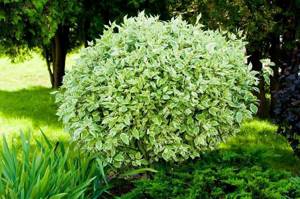
White Derain "Elegantissima"
- Gauchaultii - low (up to 1.5 m), has edged leaves with pink and yellowish-white spots.
- Siberian or Sibirica (Sibirica) - the height of the bush is one and a half meters, it has a very beautiful red tint of the branches. The leaves are green, turning yellow and red in autumn.
- Sibirica Variegata - variegated form (up to 2 m), foliage with a white border and spots; in autumn the green part of the leaf becomes brownish-purple. The shoots are bright red.
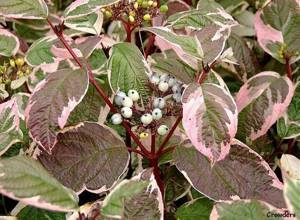
White dogwood "Sibirika variegata"
- Argenteo-marginata - leaves are distinguished by a grayish-white, as if silvery, border, shoots are dark burgundy in color.
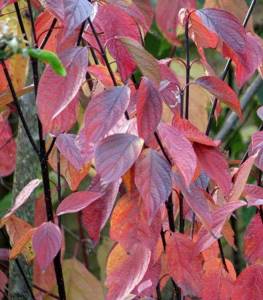
White Derain "Kesselring"
- Kesselringii is an unusually beautiful chameleon bush. The leaves are purple-brown when they bloom, then turn greenish-brown and turn bronze in autumn. The fruits are white and the shoots are black and red.
- Cream Cracker is one of the new varieties, low (about 1 m), with red shoots, the leaves have a yellowish border, which gradually becomes creamy.
There are many other varieties of white turf, all of which are distinguished by good frost resistance. Representatives of this species bloom after two years of life.
His outfits
I would also like to dwell on the forms of white tree with unusual leaf color. Thus, in the varieties 'Argenteo-marginata' and 'Elegantissima' the leaves are decorated with a bright white border, spots and stripes (the latter has a narrower border). They do not lose their color even in the shade - this is what distinguishes the turf from other ornamental leafy shrubs. Plants reach a height of 3 m. Another white-edged variety, 'Sibirica Variegata', has lower and denser bushes, with coral-red branches.
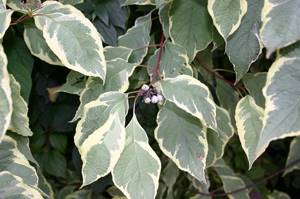
White dogwood 'Argenteo-marginata'. Photo: AiF / Svetlana Kazarova
Lovers of shrubs with golden foliage also have plenty to choose from. For example, in the form 'Aurea' the leaves bloom bright yellow and retain this color for a long time. Bushes of the 'Spaethii' variety have a height of up to 2.5 m, and each leaf is bordered along the entire perimeter with a wide golden stripe. This color lasts throughout the season, and in the spring when the leaves bloom, a beautiful reddish-orange hue is added to it. Well, the variety 'Gauchaultii' (bush height up to 1.5 m) has slightly drooping leaves covered with white, yellow and pink spots.
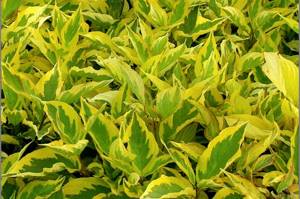
White dogwood 'Spaethii'. Photo: AiF / Svetlana Kazarova
Winter's Tale
The variety 'Sibirica' has the most elegant coral shoots. 'Atrosanguinea' has crimson-colored branches, 'Kesselringii' has purple-black branches, and the leaves have a brown tint when blooming. The 'Westonbirt' variety will delight you with dark coral-pink shoots.
Red derain, or blood-red svidina
Another species is red dogwood (Cornus sanguinea). Slightly less common in gardens than white derain. Flexible green shoots acquire a red tint over time. The pointed, ovate leaves are covered with villi. Dark green in summer, they glow in all shades of red in autumn. Thanks to the autumn color of the leaves, the species got its name. Blooms in the seventh year at the end of spring. Small white flowers are collected in inflorescences-corymbs. Sometimes re-blooming occurs. In August, black round inedible fruits ripen.
Red dogwood is also an unpretentious species, quite frost-resistant, but in very severe winters it can freeze a little.
It has decorative forms and varieties:
- Compressa (Cornus sanguinea Compressa) is a very interesting shrub with compressed, rounded leaves. The foliage is dark green in summer, turning red in autumn. The crown is dense, vertical, about 1 m high. The bark on the branches is reddish-brown. Doesn't bloom.
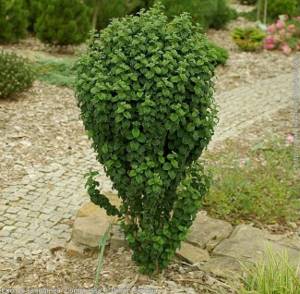
Red Derain "Compress"
- Winter Beauty (Cornus sanguinea Winter Beauty) is the owner of a round, spreading bush (about 2 m). The shoots are orange-yellow. The leaves are oval, pointed upward. Dark green in summer and red in autumn.
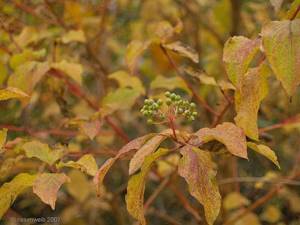
Red Derain "Winter Beauty"
- Midwinter Fire (Cornus sanguinea Midwinter Fire) is a spreading shrub up to one and a half meters, the shoots are bright red-orange. The leaves are rich green in summer, changing color from yellow-orange to dark red in autumn.
- Variegata (Cornus sanguinea Variegata) is a variety with variegated leaves, they have yellow-white spots and a border on a green background, then the leaves turn red. Young shoots are green, but gradually acquire a burgundy hue.
Let us also note some more decorative forms:
- Atro-sanguinea - with deep purple branches.
- Viridissima - distinguished by bright green fruits and shoots.
- Mietschii - young twigs and leaves of an unusual light yellow color.
The varieties of blood-red sow we considered, like the white sod, are frost-resistant.
Description of the tree
From the turf family, decorative deciduous shrubs and rarely evergreen species and trees are mainly chosen for design. Among the varieties there are creeping forms - Swedish and Canadian derain. Some varieties of the crop belong to the genus Swida (Georgian and Meyer's swida).
The plants are attractive all year round. In spring, the garden landscape is enlivened by the budding leaves, in summer - by the shape of the crown and flowering. In autumn, the shrub stands out for its amazing pink or burgundy foliage, as well as white and blue berries. In winter, derain flaunts on snowdrifts with expressive bright shoots. Depending on the species, they are bright red, yellow, burgundy and dark green.
Derain kouza, or Japanese dogwood
This species, unlike such as white dogwood and blood-red dogwood, is a tall, beautifully flowering shrub, or even a tree, and can reach a height of 9 m. The homeland of cornus kousa is Japan (also found in the wild of China and Korea).
The crown is wide-spreading, old branches descend strictly horizontally and form tiers. The leaves are oval, pointed at the top. The foliage is dark green in summer (with a bluish tint below), and with the onset of autumn their palette diverges from golden yellow to dark crimson. Flowering begins in June. The flower is a simple yellow-green head, collected from small flowers, around which bracts-involucre leaves (bractea) are located. It is the bractae (up to 9 cm) that make the flowers beautiful, as they have an interesting shape and color. At the end of August, the drupes ripen. They are pink in color and slightly round in shape, similar to strawberries (about 2 cm). The fruits are edible.
Decorative varieties:
- Satomi has rose-red bracts;
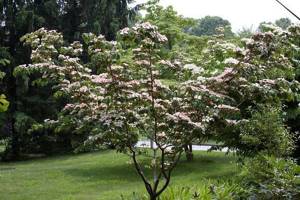
Derain kouza "Satomi"
- Gold Star is distinguished by a yellow pattern in the middle of the leaf;
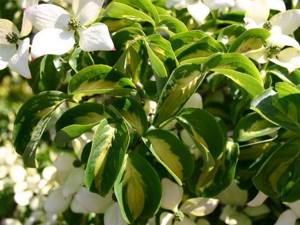
Deren kouza "Gold Star"
- Milky Way has high yields and creamy bracts;
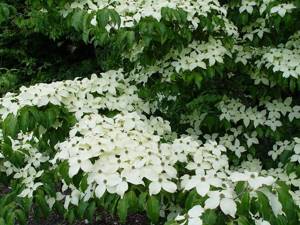
Derain kouza “Milky Way”
- Schmetterling is a profusely flowering variety with white bracts.
This species is considered an “aristocrat” and the most beautiful among its fellows. But, unfortunately, it is less resistant to our winters.
Red derain shrub: description
This plant came to us from Europe. It belongs to the dogwood family, like all other types of dogwood. In nature, it can be found on the slopes of lakes and rivers, in bush thickets, and on forest edges. Growing in the wild, the red derain shrub can grow up to four meters and is spreading.
New shoots of this plant are green but turn red over time. The foliage is abundant, dark green on the inside and light green on the underside. Unlike white dogwood shrubs, they are not decorated with spots and a white border; their charm lies in something else. Each leaf has a “hair covering”, they look very cute. In autumn, the foliage turns blood red, as do the stems, hence the name.
The derena shrub begins to bloom at the end of May and continues for three weeks. If the climate is favorable, then another flowering is possible in August. The tree first begins to bloom when it is seven years old. The flowers are creamy-white in color, collected in inflorescences as neat as those of the white tree. In autumn, the bush is covered with black fruits, but no matter how attractive they look, they are completely inedible.
The turf shrub is very beautiful in winter, especially when there is an abundance of snow. The red stripes of the plant stems are clearly visible on the white canvas, which cannot but attract admiring glances. It looks amazing, fabulously enchanting.
The turf shrub, a photo of which is in this article, should be planted in a place where there is a contrast of colors. It is winter-hardy and tolerates both drought and high humidity. The root system has many small branches, so the plant can be used not only for decoration, but also to strengthen the soil on slopes.
Blooming derain
This species came to us from North America and is a deciduous tree with a spreading crown. Flowering dogwood (Cornus florida) is famous for its abundant flowering, which occurs even before the leaves appear. The flowers are inconspicuous, small, collected in a small head. Their beauty lies in the large bracts, which come in different shades. It is these modified leaves in the spring that turn the flowers into large stars and attract the attention of others.
In the summer, the leaves of this type of tree are simply green, but in the fall, like its fellows, it does not give up its position and colors the foliage in bright yellow, orange and red tones.
This species also has decorative varieties, differing mainly in the color of the bracts.
- Rubra is the most popular of these and the bracts can be colored from light pink to deep red.
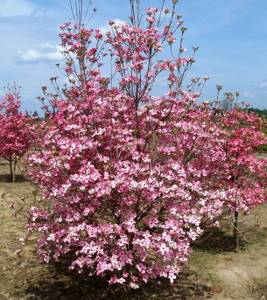
Blooming dogwood "Rubra"
- Cherokee Princess - has snow-white bracts.
- Cherokee Chief - captivates with dark pink bractae.
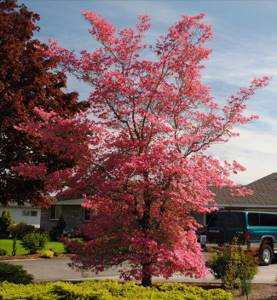
Blooming dogwood "Cherokee Chief"
Although this species can withstand frosts of more than 20 degrees, it is not as winter-hardy as white dogwood and can freeze slightly.
Recognized leader
White dogwood (Cornus alba L.) is perhaps most often found in gardens and urban landscaping. This is an erect deciduous shrub up to 3 m high. The bark of its branches is painted bright red, which is why the bushes look very beautiful in winter against the backdrop of white snow and evergreens. Large leaves, dark green above and whitish-gray below, turn bright purple and red in autumn. Inconspicuous creamy-white flowers are collected in small inflorescences. Flowering begins at the end of May and continues until late autumn, so that on one bush you can simultaneously see both flowers and round white fruits with a bluish tint.

In autumn, derens are especially elegant. Photo: AiF / Svetlana Kazarova
White dogwood can grow in any area, but feels best near ponds and on loose, moist sandy loam soils. Very valuable for household plots with close groundwater. It is shade-tolerant, grows quickly, does not spread, and only produces small root shoots in adulthood.
Male dogwood, or common dogwood
Male dogwood (Cornus mas) is well known to all of us under the name “dogwood”. It is widespread in Russia (European part), Ukraine, Moldova, the Caucasus, Western Europe and even the Middle East. In natural conditions it can grow up to 9 meters and live up to 250 years.
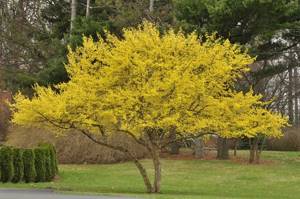
Male dogwood, or common dogwood
For most of us, this shrub is associated with red, sweet and sour, slightly pear-shaped drupes. And also with the most delicious jam made from them. However, dogwood is also used as an ornamental plant.
Its shoots are ribbed grayish-brown (young ones are yellow-green). The leaves are oval, pointed upward, covered with small hairs, rich green in color. It blooms in spring, even before the leaves appear, with yellow flowers collected in numerous umbrella inflorescences. The fruits ripen by the end of August. They are not only tasty, but also have medicinal properties.
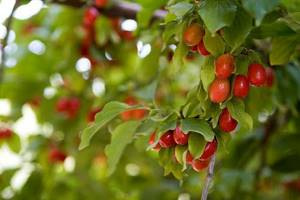
Male dogwood, or dogwood (fruit)
It is quite winter-hardy, and with partial freezing it grows quickly.
There are many dogwood varieties that are aimed at increasing productivity and fruit quality. However, there are also decorative varieties. For example, Aurea has yellow leaves, Elegantissima is a variegated variety with a wide yellow border, and Variegata has a white border.
In addition to the above species, you can also name the dwarf creeping Canadian dogwood (Cornus canadensis), but it is not frost-resistant, as well as the shoot or silky dogwood (Cornus stolonifera), which is very similar to the white dogwood, only it produces abundant growth.
It will be useful to read:
Barberry in landscape garden design Barberry is a fairly common shrub. Its widespread use in landscape design is due to the presence…
Planting derain
So, you have decided to plant turf on your property. It is better to do this in early spring. Although the species we have considered are very unpretentious, you should pay attention to some features.
Let's start choosing a location. Do not forget that these are quite tall shrubs, so consider the distance between the plants themselves, as well as to the walls of buildings and other garden objects. They are not particularly demanding of lighting, but in direct sunlight in the hot summer they can get burned. Therefore, the ideal place for them would be partial shade. Sunny locations are suitable for variegated varieties.
The soil is preferably neutral or slightly acidic, and always loose. Sand should be added to heavy clay soil.
We prepare a small hole (30-50 cm), since the roots of the derains are superficial. We arrange drainage. These plants like slightly moist soil and can tolerate slight drought, but stagnant water is harmful to them. There is no need to apply fertilizer; it is enough to prepare a nutritious soil mixture by adding humus and compost. After planting, water thoroughly and be sure to mulch the root circle.
Reproduction of derain
As a shrub, deren can be propagated by cuttings and layering, as well as by seeds. However, please note that some ornamental varieties do not bear fruit, which precludes seed propagation. And dogwood cuttings do not take root well.
When the shrub begins to bear fruit fully, having collected the berries in the fall, they can be immediately planted shallow in the ground, choosing a well-lit area. Sprinkle a thin layer of sand on top and cover with fallen leaves. In the spring, when the seeds germinate, we select the strongest specimens and leave them to grow for another 2 years. And only then should they be transplanted to the place you have chosen.
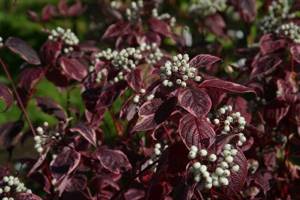
You can stratify the seeds and plant them in the spring. But it should be noted that propagation by seeds is a very long process.
When the young shoots have already become slightly woody and flexible, cuttings up to 10 cm are cut from them, dug into moist soil to a depth of approximately 3 cm and covered (you can use five-liter PET bottles). It is important to constantly monitor soil moisture; it should not dry out. It is better to plant cuttings in partial shade. In two months they will take root. They should definitely be covered for the winter, and with the onset of spring they can be transplanted to the chosen location.
The simplest propagation of dena is done by layering and suckers. To make a layering, you should bend the lower branch to the ground and dig it in (slightly injuring the bark at the place of digging). It is advisable to secure the cuttings in the ground with something. You can use a wire staple or just a not very heavy stone. And if your tree variety produces offspring, then you just need to carefully separate them and replant the young plant.
Mistakes gardeners make when growing white dogwood
We offer common mistakes in growing turf:
- For cuttings, you should not choose green cuttings. They often freeze out in winter. Preference is given to brown four-year-old shoots.
- On poor soils there is a risk that the cuttings will not take root. Be sure to apply fertilizer. Add sand, sawdust, humus or compost to clay soils. For sandy ones - peat and humus.
- When growing several turf bushes in one flower bed, plant them no closer than 3-4 m from each other. The ten-year-old plant grows up to 4 m wide.
- The bush is transplanted in the spring along with a lump of earth into a previously prepared and fertilized hole. If the root system is damaged, the development of the plant will slow down.
Features of care
As has been noted more than once, derain is a very undemanding plant. But he also needs minimal care.
Watering
Given the superficial location of the root system, the soil under the bush should be constantly moist, but it is not recommended to over-water the turf. Constant mulching is advisable. In tree-like forms, ground cover perennials can be planted around the trunk; they will help retain moisture.
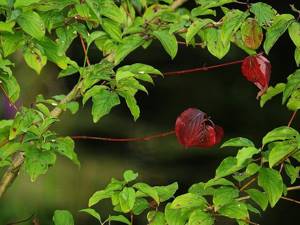
Loosening
Aeration is important for this plant, so regular loosening is recommended. It is important to loosen the soil shallowly so as not to damage the surface roots of the shrub.
Top dressing
Derain feels fine even without fertilizers, but spring comprehensive feeding of an adult plant will not be superfluous. It is important not to alkalize the soil.
Wintering
The types of derain we have considered are relatively winter-hardy. The question of shelter for the winter should be considered in relation to your climatic conditions. First-year seedlings require mandatory shelter. The most winter-hardy species is white derain.
Trimming
Derain tolerates pruning well; it should be done depending on the type of use of the plant. In old branches, the bright color disappears over time. If you want to see your bush beautiful in winter, then in early spring (before the leaves appear) the bush is pruned radically, leaving only 20 cm of height. This will renew the bush and give rise to many young bright shoots. This pruning is done every few years. Or you can simply cut out the old branches in the spring, leaving young growth.
To maintain beautiful foliage, sanitary and shaping pruning is required, since without this, the lower branches of the bush will become bare over time.
And the hedge should be trimmed after the young shoots slow down their active growth (in the second half of summer).
They begin to trim the tree in the fourth year of life.
Diseases and pests
Diseases most often affect turf due to errors in care, for example, severe waterlogging leads to rotting of the roots, as well as the development of fungal diseases. Here you can recommend reducing watering and using colloidal sulfur or Bordeaux mixture. A turf growing in good conditions is rarely attacked by pests. Most often they move from neighboring affected plants. Here it is necessary to use insecticides.
Popular forms and varieties of white turf
Elegantissima
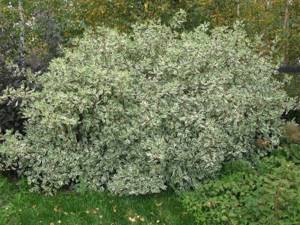
A shrub with dark red branches, cream flowers and long green leaves with a light edge.
Sibirica
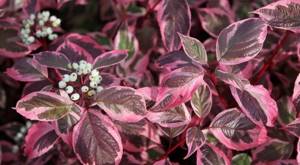
Perhaps this is the most popular turf. The leaves of the plant sometimes turn red even before autumn. The variegata variety, with spotted leaves, is widely popular.
Aurea
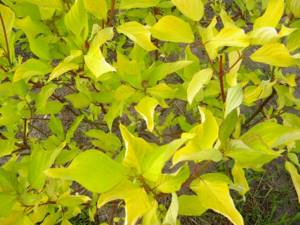
The shrub is attractive due to its succulent yellow leaves.
Shpeta (Spaethii)
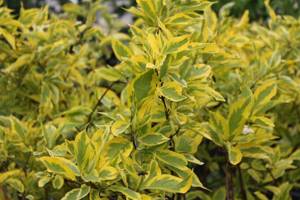
The mottled yellow-green leaves go well with the bright red branches. Cream inflorescences and white berries are sometimes lost against the background of light foliage.
Kesselrings (Kesselringii)
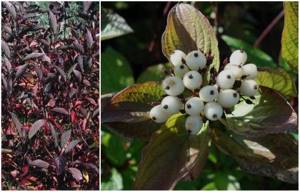
This is the most cold-resistant turf; it does not freeze in winter even at a temperature of –45°C. The dark red branches of the shrub combine well with the reddish-green leaves, which become even darker and purple in the fall.
| January | February | March | April | May | June | July | August | September | October | november | December | ||||||||||||||||||||||||
| Variegated leaves changing color | |||||||||||||||||||||||||||||||||||
| White flowers | |||||||||||||||||||||||||||||||||||
| White berries | |||||||||||||||||||||||||||||||||||
| Red-burgundy bark on branches | |||||||||||||||||||||||||||||||||||
|

